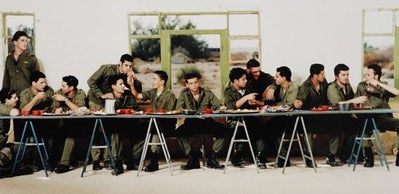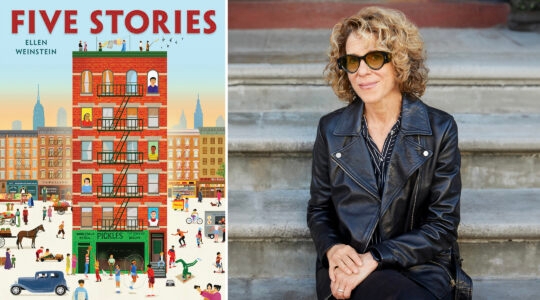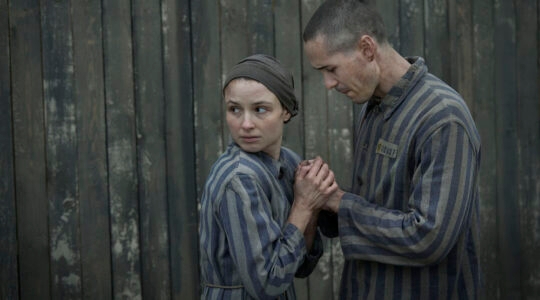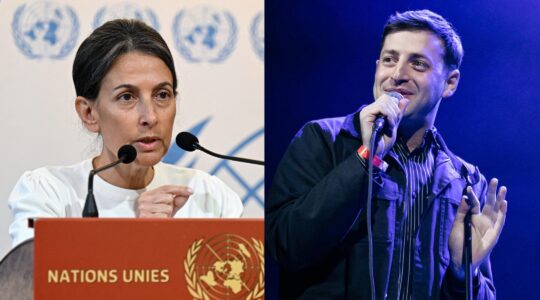NEW YORK (JTA) – Soon after Israeli photographer Adi Nes completed his 1999 work “Untitled (The Last Supper),” a staged image of Israeli soldiers positioned to evoke Leonardo da Vinci’s painting of the same event, a collector paid him $1,000 for a print. A few weeks later, a second collector offered $1,500. So when the picture sold in February at Sotheby’s annual auction of Israel and Jewish art for $264,000 – more than triple the high estimate in the auction catalog, and more than double what it sold for in a 2005 auction – more than a few eyebrows raised. “Even the auction house was surprised because the estimation was low,” Nes said in a recent telephone interview from Tel Aviv, where he lives. “The funny thing was, the person who aquired it for $1,000 last year sent me an e-mail after the second auction and said that he felt he did a very good business deal.”Though it didn’t even fetch the highest price at auction – that honor went to the late painter Reuven Rubin, two of whose works sold for $324,000 each – the Nes sale is viewed by many in the art world as a milestone in the emergence of Israel as a global artistic force. The international profile of Israeli art has been on the rise for several years.It has been led by the country’s photographers but also artists in other media, including video, painting, dance and sculpture. In 2002, the video artist Michal Rovner had a solo show at the Whitney Museum in New York and Ori Gersht had one at the Tate Britain in London. The following year, nine Israeli artists were chosen for the prestigious Venice Biennale. Prices for contemporary Israeli work have also been creeping up to levels approaching luminaries like Rubin and Mordechai Ardon, another late Israeli painter.But this season, as Israel reaches its 59th year, a Rubicon of sorts has been crossed. The 2007 Sotheby’s sale brought in nearly $5 million, a 25 percent increase over the 2005 sale, and included record sales for several Israeli artists. It fell short of last year’s tally of more than $6 million, but that number was reached on the strength of just four paintings – two by Rubin and two by Marc Chagall that together accounted for more than a quarter of the total.The Sotheby’s sale is timed to coincide with Israeli Art Week in New York, an annual event begun in 2004, which has expanded to an entire season of lectures, exhibitions and special events running from February through May. This year, it will culminate May 17 with the opening of an exhibition at the Museum of Modern Art by photographer Barry Frydlender, the first Israeli to have a solo show at the museum. “I think the interest is growing,” said Rivka Saker, the director of Sotheby’s Israel who is based in Tel Aviv but spends a lot of time in New York. “The work is good; it is comparable to things done in other places; and that’s why it’s also getting more attention from the collectors and also getting higher prices.”Theories abound for the rising interest in Israeli art – from the broader explosion in the global art market to a post-9/11 fascination with the implications of life in an era of anxiety and terrorism. But the development also owes much to the efforts of Saker herself, who has emerged as a key link between Israeli artists, the international galleries that showcase their work and the collectors who buy them. “She’s the fulcrum,” Andrea Meislin, a gallery owner in New York, said
of Saker. “She’s the center around which everything else revolves.”As the founder of Artis, a nonprofit organization promoting contemporary art from the Jewish state, many of the major exhibitions of Israeli art in New York over the past three years are attributable to Saker – if not directly, than to the awareness she has studiously helped foster. Artis also draws financial support from the Andrea and Charles Bronfman Philanthropies, Lynn Schusterman, Michael and Judy Steinhardt and other leading Jewish philanthropists.Meislin credits Saker not only as a primary supporter and cheerleader for Israeli art, but also for the creation of her own gallery in Manhattan, which has itself emerged as a key launch pad for aspiring Israelis. It was at Meislin’s gallery that Frydlender had his first New York show, as part of Artis’ inaugural Israeli Art Week, and where MoMA curators first encountered his work. Frydlender won the MoMA’s attention largely on the strength of one photograph, “Flood,” which, like all his photographs, is a composite of hundreds of smaller images taken over a period of hours or weeks and then painstakingly stitched together on a computer. The method allows for a striking amount of detail in a large photograph. “Flood” was shot from the window of Frydlender’s Tel Aviv studio overlooking an Israel Defense Forces museum visited regularly by Israeli schoolchildren. In the foreground is a rooftop, sections of which are submerged in water. Beyond that a group of students struggles to stay dry as the water rushes past, their bodies pressed against the walls of a run-down building. “That picture, like some others, has a way of evoking the relationship of present day life with a biblical past that I find very remarkable,” said Peter Galassi, MoMA’s chief photography curator.The photo also evokes the tensions of contemporary Israel, where the political is never far from view – though it’s not necessarily close either. Virtually all the photographs from Current Visions: Inside Israel (Part 2), now showing at Meislin’s gallery, or from the Jewish Museum’s current exhibition Dateline Israel, a collection of photographs and video art installations, have political overtones, though many won’t be immediately apparent to those not well versed in the subtexts of Israeli society. Some will see in Freydlender’s photo “Breakwater,” shot during last summer’s war in Lebanon, a couple embracing in the sea; others will find a pair of vulnerable bodies seeking refuge from the turbulent, untamed forces around them. Rina Castelnuovo’s “Hilltop Youth,” from the Dateline Israel show, depicts a couple lighting Chanukah candles in their window; those in the know will recognize the telltale signs of a settlement outpost. The Israeli work included in “Dangerous Beauty,” an exhibition currently at New York’s Chelsea Art Museum, shows even less evidence of the themes typically associated with Israeli art. Indeed, in many ways it shows Israeli artists grappling with the same issues – in this case the idealization of particular conceptions of beauty – that preoccupy their colleagues around the world. All of which well suits the Israeli government, which has thrown its support behind Artis, and which has labored – particularly since the Palestinian uprisings – to foster an image of the Jewish state abroad that is not inextricably bound to violence and conflict.But it also suits boosters like Meislin, herself a onetime immigrant to Israel, who admits to harboring hope that by promoting Israeli art, the country can achieve a measure of normalcy in its relations with the wider world.”It thrills me that this is going to be a normal country,” Meislin said, “whose artists are going to be accepted as normal artists.”
Portrait of the artist as an Israeli

"Untitled (The Last Supper)," by Adi Nes. (Courtesy of Sotheby's)
Advertisement





